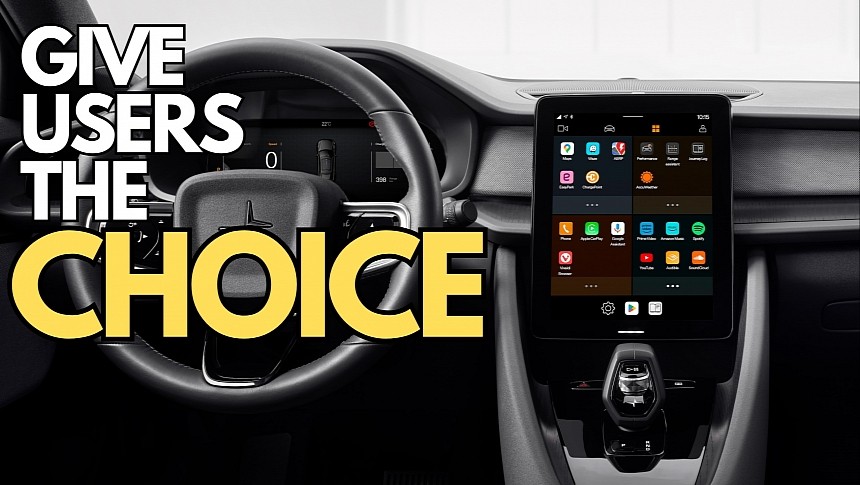General Motors' decision to block Android Auto and CarPlay in its future models and go all-in on Android Automotive wasn't received well by existing and potential future customers.
The American carmaker ditched phone mirroring system and adopting Android Automotive on all EVs beginning with the 2024 Blazer. While it's technically possible to run Android Auto and CarPlay on top of Android Automotive and offer all three systems side-by-side, giving customers the power of choosing what they want to use, GM decided to enforce AAOS in its cars.
Polestar's CEO recently commented on the controversial strategy, explaining that his company will continue to offer Android Auto and CarPlay in its cars.
CEO Thomas Ingenlath explained in an interview that customers must have the choice, adding that blocking Android Auto and CarPlay is a bad decision and shouldn’t be a way to treat customers.
Polestar admitted that Android Automotive allows for more advanced capabilities behind the wheel, but eventually, enforcing a certain system is a way to "dogmatically educate customers." The CEO reiterated that Android Auto and CarPlay will continue to be available in Polestar models, despite Android Automotive serving as the default choice.
General Motors' aggressive strategy was received with much criticism by customers worldwide, especially as other carmakers rushed to reiterate support for Android Auto and CarPlay. Porsche, Ford, Volvo, and other brands confirmed that phone mirroring systems will continue to be available in their cars in the long term, despite some of them adopting Android Automotive.
General Motors explained its decision of blocking Android Auto and CarPlay by pointing to the feature lineup bundled with Android Automotive. GM says AAOS supports capabilities unavailable on Android Auto and CarPlay and enforcing the built-in operating system is the only way to provide customers with access to the upgraded experience. Otherwise, if they stick with Android Auto and CarPlay, customers wouldn’t have the chance to try them out.
Compared to Android Auto and CarPlay, Android Automotive is a fully featured operating system, sporting deeper integration into the vehicle and access car data otherwise not available for phone mirroring systems. For example, Android Automotive can read battery information and offer more advanced Google Assistant systems. Drivers can control the climate system with voice commands, allow Google Maps to monitor the battery level and suggest charging stops, and prepare the battery for charging when they drive to a selected station.
Android Auto and CarPlay require a mobile device to run and have no access to vehicle data. Apple's data shows that nearly eight in ten new-car buyers in the United States consider CarPlay a must-have system and wouldn’t otherwise purchase a vehicle unless it comes with the feature built-in. Google has recently revealed that over 200 million vehicles on the road already come with Android Auto.
Polestar's CEO recently commented on the controversial strategy, explaining that his company will continue to offer Android Auto and CarPlay in its cars.
CEO Thomas Ingenlath explained in an interview that customers must have the choice, adding that blocking Android Auto and CarPlay is a bad decision and shouldn’t be a way to treat customers.
Polestar admitted that Android Automotive allows for more advanced capabilities behind the wheel, but eventually, enforcing a certain system is a way to "dogmatically educate customers." The CEO reiterated that Android Auto and CarPlay will continue to be available in Polestar models, despite Android Automotive serving as the default choice.
General Motors' aggressive strategy was received with much criticism by customers worldwide, especially as other carmakers rushed to reiterate support for Android Auto and CarPlay. Porsche, Ford, Volvo, and other brands confirmed that phone mirroring systems will continue to be available in their cars in the long term, despite some of them adopting Android Automotive.
General Motors explained its decision of blocking Android Auto and CarPlay by pointing to the feature lineup bundled with Android Automotive. GM says AAOS supports capabilities unavailable on Android Auto and CarPlay and enforcing the built-in operating system is the only way to provide customers with access to the upgraded experience. Otherwise, if they stick with Android Auto and CarPlay, customers wouldn’t have the chance to try them out.
Compared to Android Auto and CarPlay, Android Automotive is a fully featured operating system, sporting deeper integration into the vehicle and access car data otherwise not available for phone mirroring systems. For example, Android Automotive can read battery information and offer more advanced Google Assistant systems. Drivers can control the climate system with voice commands, allow Google Maps to monitor the battery level and suggest charging stops, and prepare the battery for charging when they drive to a selected station.
Android Auto and CarPlay require a mobile device to run and have no access to vehicle data. Apple's data shows that nearly eight in ten new-car buyers in the United States consider CarPlay a must-have system and wouldn’t otherwise purchase a vehicle unless it comes with the feature built-in. Google has recently revealed that over 200 million vehicles on the road already come with Android Auto.







